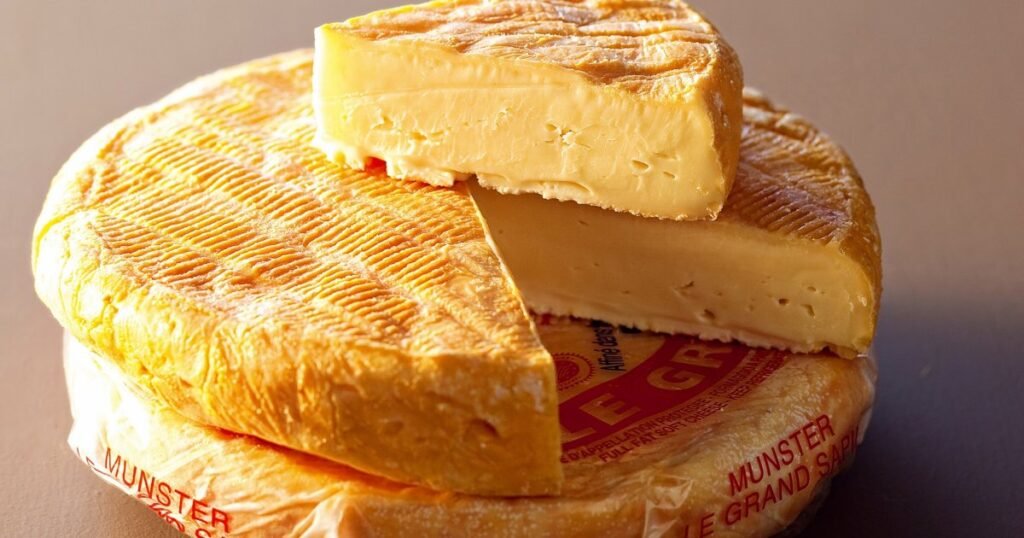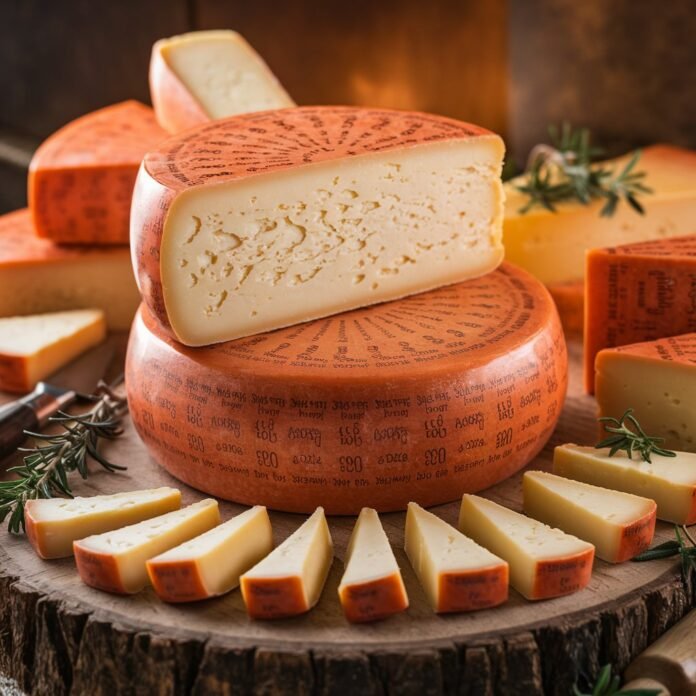Introduction
Muenster cheese is a beloved variety that holds a special place in the hearts of cheese enthusiasts across the United States. Its mild flavor, creamy texture, and versatility make it a staple in many households. Whether you’re using it in a classic grilled cheese sandwich, melting it on a burger, or enjoying it with crackers, Muenster cheese is a go-to for many.
Muenster cheese is a mild, white cheese with a reddish-orange rind made from paprika, which can be eaten but is often cut off. It has a semi-firm texture with a smooth, creamy consistency and a subtle, tangy flavor.
In this comprehensive guide, we’ll explore everything you need to know about Muenster cheese. We’ll cover its origins, production process, nutritional benefits, culinary uses, and much more. By the end of this article, you’ll have a deep understanding of Muenster cheese and why it deserves a prominent place in your kitchen.
The Origins of Muenster Cheese
A Brief History
The origins of Muenster cheese can be traced back to Europe, specifically to the Alsace region, which straddles the border between France and Germany. The name “Muenster” comes from the town of Munster in the Alsace region, where the cheese was first produced by Benedictine monks in the Middle Ages. These monks created the cheese as a way to preserve milk and provide sustenance during the long winters.
However, it’s important to note that the Muenster cheese we know today in the United States is quite different from its European counterpart. While European Munster cheese is a strong-smelling, washed-rind cheese with a robust flavor, American Muenster is much milder and has a smooth, creamy texture.
Muenster Cheese in America
Muenster cheese made its way to America with European immigrants who brought their cheese-making traditions with them. Over time, American cheesemakers adapted the recipe to suit local tastes, resulting in the mild, semi-soft cheese we enjoy today. American Muenster cheese is typically made from cow’s milk and has a pale color with a characteristic orange rind, which is created by adding annatto, a natural coloring agent.
The Production Process of Muenster Cheese
Milk Selection and Preparation
The production of Muenster cheese begins with the selection of high-quality cow’s milk. The milk is pasteurized to kill any harmful bacteria and then cooled to the appropriate temperature for cheese-making.
Coagulation
Once the milk is ready, a starter culture of lactic acid bacteria is added to begin the fermentation process. This culture helps develop the flavor of the cheese and increases the acidity of the milk. After the culture has been added, rennet, an enzyme, is introduced to coagulate the milk, forming curds.
Cutting and Cooking the Curds
The curds are then cut into small pieces, which allows the whey (the liquid portion) to separate from the curds (the solid portion). The curds are gently stirred and heated to a specific temperature to help them firm up and release more whey.
Draining and Shaping
Once the curds have reached the desired consistency, they are drained of the remaining whey and placed into molds. The curds are pressed to remove any excess whey and to shape the cheese into its final form.
Salting and Aging
After the cheese has been shaped, it is salted to enhance the flavor and preserve the cheese. The cheese is then aged for a period of time, typically a few weeks, to develop its mild flavor and smooth texture. During the aging process, the cheese is regularly washed and turned to ensure even aging and to prevent the growth of unwanted bacteria.
The Orange Rind
The characteristic orange rind of Muenster cheese is created by rubbing the surface of the cheese with annatto, a natural coloring agent derived from the seeds of the achiote tree. This rind is edible, but many people prefer to remove it before consuming the cheese.
Nutritional Benefits of Muenster Cheese
Muenster cheese is not only delicious but also offers several nutritional benefits. Here’s a breakdown of the key nutrients found in Muenster cheese:
- Protein: Muenster cheese is a good source of protein, which is essential for building and repairing tissues in the body. A one-ounce serving of Muenster cheese contains about 5-6 grams of protein.
- Calcium: Like most dairy products, Muenster cheese is rich in calcium, which is crucial for maintaining strong bones and teeth. A one-ounce serving of Muenster cheese provides approximately 200 milligrams of calcium, which is about 20% of the recommended daily intake.
- Vitamins: Muenster cheese contains several important vitamins, including vitamin A, which supports vision and immune function, and vitamin B12, which is essential for red blood cell formation and neurological function.
- Fats: Muenster cheese is a source of dietary fat, including saturated fat. While fat is necessary for absorbing certain vitamins and providing energy, it’s important to consume it in moderation.
- Calories: A one-ounce serving of Muenster cheese contains approximately 100 calories. This makes it a calorie-dense food, so portion control is key if you’re watching your calorie intake.

Culinary Uses of Muenster Cheese
Muenster cheese is incredibly versatile and can be used in a wide range of dishes. Here are some popular ways to incorporate Muenster cheese into your cooking:
Grilled Cheese Sandwiches
Muenster cheese is a favorite choice for grilled cheese sandwiches because of its excellent melting properties. The cheese becomes gooey and stretchy when melted, making for a delicious and satisfying sandwich.
Recipe Idea: Try making a Muenster grilled cheese with slices of sourdough bread, a layer of thinly sliced apples, and a drizzle of honey. The combination of flavors is both sweet and savory, with a perfect balance of textures.
Burgers and Sandwiches
Muenster cheese is often used as a topping for burgers and sandwiches. Its mild flavor complements a variety of ingredients without overpowering them.
Recipe Idea: Add a slice of Muenster cheese to a turkey burger with avocado, lettuce, and tomato for a delicious and healthy meal. The creamy cheese pairs well with the lean turkey and adds richness to the burger.
Macaroni and Cheese
Muenster cheese can be used in macaroni and cheese for a smooth and creamy sauce. Its mild flavor works well with sharper cheeses like cheddar or Gruyère, creating a balanced and rich dish.
Recipe Idea: Make a three-cheese macaroni and cheese with Muenster, sharp cheddar, and Parmesan. The combination of flavors will give the dish depth, while the Muenster cheese ensures a creamy texture.
Cheese Platters
Muenster cheese is a great addition to a cheese platter, especially when paired with fruits, nuts, and crackers. Its mild flavor provides a contrast to stronger cheeses and allows for a variety of pairings.
Pairing Idea: Serve Muenster cheese with grapes, dried apricots, almonds, and whole-grain crackers. The sweetness of the fruit and the crunch of the nuts complement the creamy texture of the cheese.
Baking
Muenster cheese can also be used in baking, particularly in savory pastries and quiches. Its melting properties make it ideal for dishes that require a gooey, cheesy center.
Recipe Idea: Bake a quiche with Muenster cheese, spinach, and mushrooms for a delicious brunch dish. The mild flavor of the cheese allows the vegetables to shine while adding a creamy texture to the quiche.
Muenster Cheese in Different Cuisines
While Muenster cheese is a staple in American cuisine, it can also be found in various dishes from around the world. Here’s how Muenster cheese is used in different culinary traditions:
French Cuisine
In France, the original Munster cheese is a much stronger variety with a pungent aroma and robust flavor. However, American Muenster can be used as a milder alternative in French-inspired dishes, such as croque monsieur or gratins.
German Cuisine
Given its European origins, Muenster cheese pairs well with German cuisine, particularly in dishes like spätzle (German egg noodles) or käsespatzle, a type of German mac and cheese.
Recipe Idea: Make a German-style käsespatzle with caramelized onions and Muenster cheese. The cheese melts beautifully, creating a creamy, comforting dish.
American Cuisine
Muenster cheese is commonly used in classic American dishes, such as cheeseburgers, grilled cheese sandwiches, and casseroles. Its mild flavor and melting properties make it a versatile ingredient in comfort foods.
Storing and Serving Muenster Cheese
To get the most out of your Muenster cheese, it’s important to store and serve it correctly. Here are some tips:
Storing Muenster Cheese
- Refrigeration: Muenster cheese should be stored in the refrigerator, wrapped in wax paper or parchment paper, and then placed in a plastic bag or airtight container. This prevents the cheese from drying out while allowing it to breathe.
- Shelf Life: When stored properly, Muenster cheese can last for about 2-3 weeks in the refrigerator. If the cheese develops mold, it’s best to discard it.
- Freezing: While it’s possible to freeze Muenster cheese, it may affect the texture. If you do freeze it, wrap it tightly in plastic wrap and place it in a freezer bag. Thaw it in the refrigerator before using.
Serving Muenster Cheese
- Room Temperature: For the best flavor and texture, serve Muenster cheese at room temperature. Take it out of the refrigerator about 30 minutes before serving.
- Pairings: Muenster cheese pairs well with a variety of foods, including fruits like apples and pears, nuts like almonds and walnuts, and breads like baguettes and sourdough.
FAQs About Muenster Cheese
What is the difference between American Muenster and French Munster?
American Muenster is a mild, semi-soft cheese with a smooth texture and a pale color, while French Munster is a stronger, washed-rind cheese with a pungent aroma and robust flavor. The two cheeses share a name but are quite different in taste and texture.
Is the orange rind on Muenster cheese edible?
Yes, the orange rind on Muenster cheese is edible. The rind is created by rubbing the cheese with annatto, a natural coloring agent. However, some people prefer to remove the rind before eating.
Can Muenster cheese be used in place of other cheeses?
Muenster cheese can be used as a substitute for other mild, semi-soft cheeses like Monterey Jack or Havarti. Its mild flavor and good melting properties make it a versatile option in many dishes.
Is Muenster cheese a good source of calcium?
Yes, Muenster cheese is a good source of calcium, providing about 20% of the recommended daily intake in a one-ounce serving. Calcium is essential for maintaining strong bones and teeth.
How should I store Muenster cheese?
Muenster cheese should be stored in the refrigerator, wrapped in wax paper or parchment paper, and then placed in a plastic bag or airtight container. This prevents the cheese from drying out while allowing it to breathe.
Conclusion
Muenster cheese is a versatile and delicious cheese that deserves a spot in your kitchen. Its mild flavor, creamy texture, and excellent melting properties make it a favorite for a wide range of dishes, from grilled cheese sandwiches to gourmet cheese platters.
Understanding the origins, production process, and culinary uses of Muenster cheese can enhance your appreciation of this classic American cheese. Whether you’re a seasoned cheese lover or just discovering Muenster for the first time, this guide provides all the information you need to enjoy this delightful cheese to the fullest.




